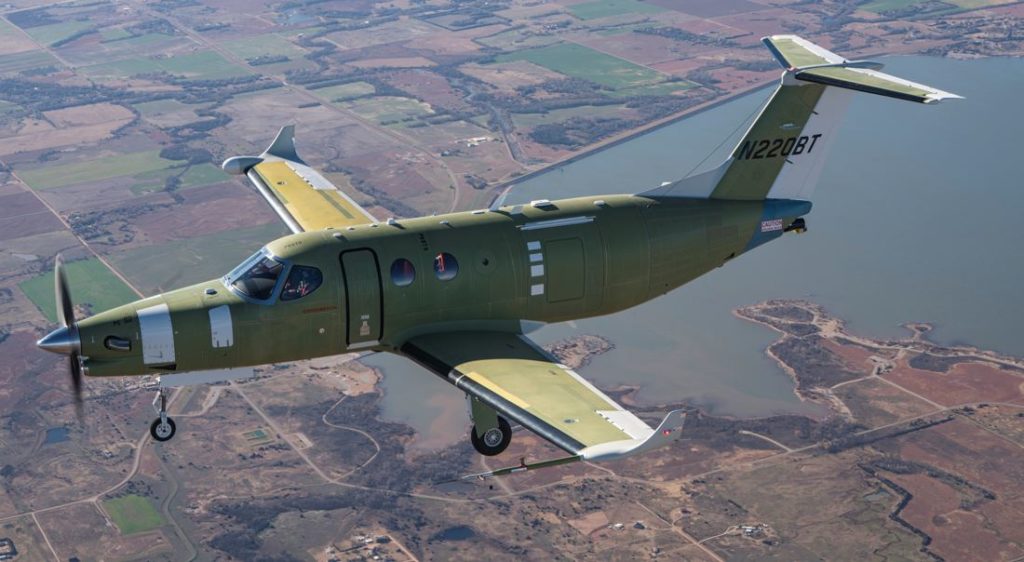Estimated reading time 6 minutes, 10 seconds.
Textron Aviation Inc. announced that the Beechcraft Denali’s flight test program has officially begun. The single-engine turboprop, designed and manufactured by Textron, marked its first flight on Nov. 23. The OEM described the flight as “a major step for the clean-sheet design aircraft.”
At approximately 8:20 a.m., the Denali prototype aircraft, piloted by senior test pilot Peter Gracey and chief test pilot Dustin Smisor, took off from the company’s campus at Eisenhower National Airport, Kansas. Reaching speeds of 180 knots and an altitude of 15,600 feet, the two-hour-and-50-minute flight put the Denali’s performance, stability, and control to the test.

“From the beginning of the flight to the end, the Denali was simply flawless,” said Gracey. “It’s just a great aircraft to fly. The Catalyst engine was outstanding, and the aircraft performed to the levels we were anticipating. First flights really can’t go more smoothly than this. We are really off to an excellent start for the Denali flight test program.”
Textron’s president and CEO, Ron Draper, referred to the milestone as “a significant occasion for the Denali,” also equally as momentous for Textron’s employees, suppliers, and customers “who will be flying this aircraft.”
The Beechcraft Denali was first revealed as the Cessna Denali at EAA AirVenture Oshkosh 2016, as a “new challenger to single-engine turboprops.” It is designed to reach cruise speeds up to 285 knots, with a full fuel payload of 1,100 pounds, and a range of 1,600 nautical miles at a high-speed cruise.
In July 2021, Textron announced it was “realigning its turboprop aircraft lineup as the single-engine Beechcraft Denali joins the legendary twin-engine Beechcraft King Air 260 and King Air 360/360ER as part of the company’s high-performance turboprop product lineup.”
The prototype’s first ground engine runs, which took place at Textron’s west campus in Wichita, Kansas, were completed in late August 2021, verifying the functionality of the fuel system and engine, as well as the interface with the avionics and electrical systems
Powered by GE’s 1,300-shaft-horsepower Catalyst engine, the Denali “burns up to 20 percent less fuel than older turboprop technologies.” And with the ability to use sustainable aviation fuel, the single-engine turboprop is environmentally friendly. As well, the engine “eases pilot workload with its single-lever power and propeller control,” Textron said.
“[With the] largest cabin in its class, this is an aircraft that will change the landscape for high-performance, single-engine turboprop aircraft,” added Draper.
The cabin features a standard seating configuration of six individual reclining seats and offers a nine-place high density seating option. As well, the cabin can easily be converted between passenger and cargo configurations.
While the first flight challenged the stability and control of the aircraft, testing was performed on the overall propulsion, environmental impact, flight controls, and avionics systems.
According to Textron, the first flight is part of “a long list of important accomplishments as we prepare the aircraft for certification and customer deliveries.”
The Denali cockpit features the Garmin G3000 avionics suite (with high-resolution and touchscreen controllers), Garmin autothrottle (with the Automatic Flight Control System), and Flight Management System.
According to Textron, the aircraft “will be able to fly from Los Angeles to Chicago, New York to Miami, or London to Moscow.”
The company is aiming for certification by 2023. After that, the prototype aircraft, “along with two additional flight test articles and three full airframe ground test articles, will continue to expand on operational goals, focusing on testing aircraft systems, engine, avionics, and overall performance.”